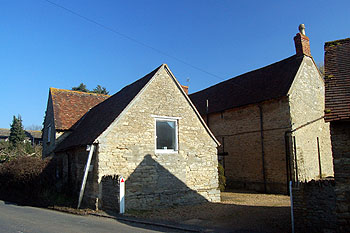
Middle Farmhouse March 2011
Middle Farmhouse formed part of the Oakley estate, purchased by the Duke of Bedford in 1737 with the Lordship of the Manor of Oakley Reynes [R1/37]. It was listed by the former Department of Environment in August 1987 as Grade II, of special interest. The department dated the property to the 17th or early 18th century meaning it was built before the Dukes of Bedford became Lords of the Manor. A new range was added at the south end probably in the early 19th century.
The house is built of coursed limestone rubble with an old clay tile roof. The original main wing of two storeys is built gable end to the road. The 19th century south wing is of two storeys and attics.
The Duke of Bedford put the Oakley House Estate up for sale by auction on 31st October 1918. Middle Farmhouse formed Lot 27 and was described as follows [AD1147/18].
The Valuable Small Holding
KNOWN AS
The Oakley Post Office, Buildings and Land
Held, with other lands, by Mr. E. Newell on a Yearly Michaelmas Tenancy, and extending to about
2 acres 2 roods 10 poles
(2.564 Acres)
The House, stone built and tiled, contains Two Sitting Rooms, Post Office, Bakehouse, Kitchen, Scullery, Cellar and Four Bedrooms over. Buildings: - Barn, Two-stall Stable, Trap House, HayBay, Coal Shed, Fowl's House, two Pigsties and Boiling House, together with the Enclosure of Pasture Land being Part [Ordnance Survey Field] Number 41 and Part 43 on Plan
NOTE – This Lot is sold subject to an easement for a drain pipe across field Part 41 from the Methodist Chapel, permitted under and agreement determinable by three months' notice.
The Rating Valuation Act 1925 stated that every piece of land and building in the country was to be assessed to determine its rateable value. Oakley, like most of the county, was assessed in 1927 and the valuer visiting the post office [DV1/C107/106] found it owned and occupied by Edward F. Newell who had, presumably, bought it in 1918. The valuer noted that the rent in 1918 had been £25 per annum.
The valuer listed the post office itself, two sitting rooms, a kitchen and a scullery with four bedrooms upstairs. The second floor comprised two attics which were used as store rooms. A barn and an earth closet stood outside. Water had to be fetched from across the road. The valuer commented: "South elevation Nice. Muddly old Place. Old Thick Walls … Semi Farm House".
The adjoining farm buildings were also owned by Newell and comprised: two corrugated iron open hovels; a wood and corrugated iron loose box; a wood and corrugated iron cow house for four beasts; a wood and tiled single stable; a wood and tiled cow shed for four beasts; two pigsties; a stucco and tiled chaff house; two stables each with two stalls; a loose box and a coal barn. The valuer commented: "Poor old Lot". Newell also owned a "useful grass field" of 2.140 acres. Alterations were carried out on the property in 1947 [RDBP3/942].
Oakley historian Bill Knight purchased Middle Farm on the death of Edward Newell, his grandfather, in 1947 when he made alterations to the property [RDBP3/942]. Some years later he made notes for Bedfordshire and Luton Archives and Records Service [CRT190/152] in which he revealed that Newell had lived at Middle Farm since about 1890. He was a correspondent for the Bedfordshire Times from 1892 to 1942. Directories for Bedfordshire, which were not published annually but every few years, give the names of the postmasters and mistresses of Oakley from 1869 until 1936 and Edward Newell is listed from 1898 to 1924. A previous postmaster was James Jones from at least 1869 to at least 1877, then a postmistress, Betsy Pack, in 1885.
The 1871 census shows James Jones as a maltster and, unfortunately, it is not possible to pinpoint where he lived; his entry is eleven entries after the entry for the Bedford Arms but one does not know whether the enumerator was walking north or south and how he dealt with the two sides of the road. The 1881 census shows John Pack, Betsy's husband as postmaster, they lived at 13 The Village, a property which, the 1883 Ordnance Survey Map shows, was about half way between the Bedford Arms and Middle Farmhouse and on the same side of the road. Edward Newell's successor as postmistress was Mrs. Louisa Clewer from at 1928 to at least 1936 and, with her, the post office moved location again as Newell continued to inhabit Middle Farm.